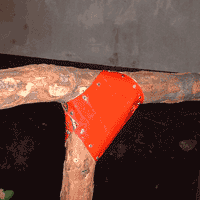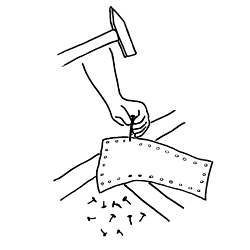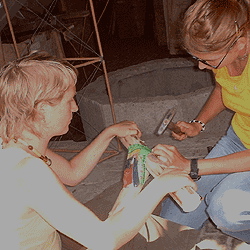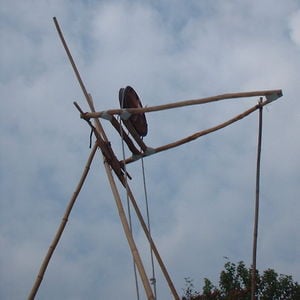How to weld wood
(Redirected from Weld wood)

This is a technique to join wood using scrap tin, such as that from a used can.
Materials needed[edit | edit source]

- Two sticks of wood to be joined.
- Make sure the wood is in good condition where the connection is to be made. It should be clean, no bits of bark or loose paint, and no knots, as they are too hard for nails.
- Two pieces of thin tin.
- For the first bond.
- Use a knife for cutting the tin from a small can for example.
- Length and width equal to the stick diameter.
- One piece of sheet metal.
- For the final bond.
- Use the tip of an axe or chisel for cutting the sheet metal from an oil drum for example.
- Width 3x the stick diameter.
- Length 6x the stick diameter.
- Some small, ~1 cm, nails for the first connection.
- Some larger, ~2.5 cm, nails for the final connection.
Provisional interconnection[edit | edit source]

- Determine the best position for the two sticks.
- Fasten, or have someone hold, the sticks in position.
- Use the two pieces of thin tin and the small nails to make a provisional connection on both sides of the wood as shown.
- Do not put load on the wooden parts, just use the connection to see if it really suits your plans.
Prepare small holes for the 2.5 cm nails[edit | edit source]

- Use a sharp pin or nail (~ 8cm) to pierce holes in the sheetmetal
- No larger than needed for the nails. The little indents you make will later fit the head of the nail, the bur on the back side will later give extra hold when driven into the wood.
- Pierce the holes close to the edge (0.5 cm) and about 2 cm apart.
Positioning the sheet on the joint[edit | edit source]

It takes some experience to do this right, but in general:
- Cover the joint between the sticks with sheetmetal enough to allow the corners to be bent down.
- Drive in three nails to fasten the sheet in that posision.
Bend corners down and nail them at this side[edit | edit source]


Once the sheet is properly fixed into position, you can:
- Bend the corners of the sheet down.
- Hammer the edge of the sheet to nestle it against the wood.
- Drive in the nails, at this side of the joint.
Hammer the sheet around to the other side[edit | edit source]

- Lift the joint from the floor and bend the sheet over in a few steps.
- After each bit of bending, re-hammer the edge to make it nestle itself against the wood.
- Fix it with a nail.
- Repeat these steps until the sheet is wrapped all around the joint.
Fasten the sheet all round[edit | edit source]

The joint is now building up strength. Add extra strength by inspecting how the edge flows against the wood. Where there is some opening:
- Close it by driving the sheet down with light hammering.
- Pierce the sheet with the sharp pin.
- Add another nail.
- Repeat as necessary.
- Finally make sure there are no bits of sheet or nails sticking out. If so, hammer them down, so they merge with the wood.
- Inspect the result by letting your fingers glide around the joint. It should feel smooth all around.
This is as it should look when finished[edit | edit source]


- The corners of the sheet should just overlap, making a circle not a spiral.
- At the corners the nails pierce both layers of sheet metal, closing the loop around the wood!
- Only the corners overlap. If the sheet is too long, cut off a portion of the sheet to correct this.
- Finally inspect again to see that the joint is smooth on the outside, so it cannot hook into skin or clothes.
- If you are not satisfied, correct it or replace it. To remove:
- Pry sheet with a knife or screwdriver.
- Pull the sheet away from the wood with a pair of plyers. If done with care, the nails come out straigt for re-use.
- Hammer the sheet flat and start anew. Just as with electric welding of metal, welding wood takes practice to do well.